IOCCG News
On behalf of the IOCCG, we hope that all our friends and colleagues in the global ocean colour community are safe and well during these challenging times. The past few months have been unprecedented for all of us, but we can get through this with patience and strength. The IOCCG will continue to support you in any way we can.
2020 Summer Lecture Series
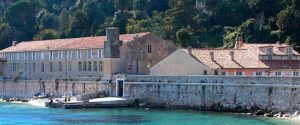 With the numerous travel advisories and institutional travel restrictions due to the global COVID-19 pandemic, the IOCCG has had no choice but to cancel the 2020 Summer Lecture Series, originally scheduled for 22 June – 3 July 2020, in Villefranche-sur-Mer, France. Preparing for this training course involved a considerable amount and time and effort by the course coordinator, Dr. David Antoine (Curtin University, Australia), as well as all the volunteer lecturers. We are most grateful for their efforts, and are profoundly disappointed not to be able to hold the training course as planned.
With the numerous travel advisories and institutional travel restrictions due to the global COVID-19 pandemic, the IOCCG has had no choice but to cancel the 2020 Summer Lecture Series, originally scheduled for 22 June – 3 July 2020, in Villefranche-sur-Mer, France. Preparing for this training course involved a considerable amount and time and effort by the course coordinator, Dr. David Antoine (Curtin University, Australia), as well as all the volunteer lecturers. We are most grateful for their efforts, and are profoundly disappointed not to be able to hold the training course as planned.
It is most unfortunate for the selected top 22 students, who have lost a valuable opportunity — we extend our sincere apologies to them and wish them best of luck with their careers. We also thank all 112 applicants for the time and effort they put into their excellent applications. Unfortunately, it is not possible to reschedule the training course due to conflicts with other training courses and meetings, as well as the availability of the lecturers. Excellent training resources are, however, available: video recordings and PowerPoint presentations of all the lectures from past IOCCG Summer Lecture Series are available on the IOCCG website, and video lectures of all the Ocean Optics classes at the University of Maine are also available online. The next IOCCG Summer Lecture Series will likely be held in June/July 2022.
IOCCG Annual Committee Meeting

 The annual IOCCG Committee meeting, originally scheduled to take place from 27–29 March 2020 in Tokyo, Japan, was cancelled due to concerns over the coronavirus pandemic. On behalf of the IOCCG we thank our hosts, the Japan Aerospace Exploration Agency (JAXA), for all the time and effort they put in to arranging the meeting. The next IOCCG Committee meeting is tentatively being organized for early February 2021, in ESA-ESRIN, Rome (Italy).
The annual IOCCG Committee meeting, originally scheduled to take place from 27–29 March 2020 in Tokyo, Japan, was cancelled due to concerns over the coronavirus pandemic. On behalf of the IOCCG we thank our hosts, the Japan Aerospace Exploration Agency (JAXA), for all the time and effort they put in to arranging the meeting. The next IOCCG Committee meeting is tentatively being organized for early February 2021, in ESA-ESRIN, Rome (Italy).
IOCCG In Situ Radiometry Protocols Available
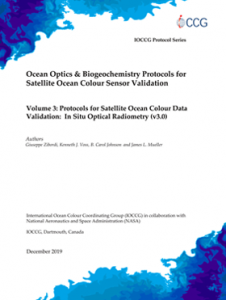 We are pleased to announce that the Joint Research Centre (JRC, Italy) has printed, and also kindly offered to mail hardcopies of the IOCCG “Protocols for Satellite Ocean Colour Data Validation: In Situ Optical Radiometry (2019)”, edited by Zibordi, G., Voss, K. J., Johnson, B. C. and Mueller, J. L. (Vol. 3.0).
We are pleased to announce that the Joint Research Centre (JRC, Italy) has printed, and also kindly offered to mail hardcopies of the IOCCG “Protocols for Satellite Ocean Colour Data Validation: In Situ Optical Radiometry (2019)”, edited by Zibordi, G., Voss, K. J., Johnson, B. C. and Mueller, J. L. (Vol. 3.0).
If you would like to receive a hardcopy of these protocols, please complete the protocols request form on the IOCCG website at: https://ioccg.org/radiometry-protocols-request. If you would like to request more than one hardcopy, please email Dr. Giuseppe Zibordi directly at: giuseppe.zibordi@ec.europa.eu.
In Memoriam
We are deeply saddened to announce the passing of Prof. Trevor Platt (1942-2020), a world-renowned scientist as well as a leader in international cooperation and capacity development. He played an especially important role in the IOCCG, being one of the founding members of the group, and serving as the first Chair of the IOCCG for a period of 10 years (from 1996-2006). Through his strong leadership skills the IOCCG gained international recognition for their Scientific Report Series and training courses, and became the principal forum for space agencies and the ocean-colour community to develop consensus at a global scale.
Prof. Platt was an inspiration to many people and took a particular interest in capacity building for scientists from developing countries. His death will leave a void in the hearts of so many people from around the world, but his legacy will live on for many years. On behalf of the IOCCG Committee we extend our deepest condolences to his family and friends, and especially to his loving wife Dr. Shubha Sathyendranath, who has been by his side for more than three decades.
News from NOAA
 The NOAA JPSS Dedicated VIIRS Ocean Color Cal/Val Cruise participants had their bags packed and indeed some equipment already shipped in anticipation of the sixth field campaign of the series that began in 2014. While the NOAA in situ validation program has grown accustomed to working around the logistical challenges of hurricanes (Matthew in 2016, and Dorian in 2018) and major ship repairs (spring, 2019), the COVID-19 pandemic resulted in the cancellation of the 2020 cruise planned on the NOAA Ship Oscar Elton Sette which was to sail from Honolulu and was to include some sampling near the MOBY site. An alternative cruise for later in 2020 appears unlikely at this time but the request for ship time for next year’s cruise has been filed. In the meantime, the fifth cruise report is in progress, which will document the September 2019 campaign aboard NOAA Ship Gordon Gunter that sailed from Newport Rhode Island covering the US East Coast mid-Atlantic region.
The NOAA JPSS Dedicated VIIRS Ocean Color Cal/Val Cruise participants had their bags packed and indeed some equipment already shipped in anticipation of the sixth field campaign of the series that began in 2014. While the NOAA in situ validation program has grown accustomed to working around the logistical challenges of hurricanes (Matthew in 2016, and Dorian in 2018) and major ship repairs (spring, 2019), the COVID-19 pandemic resulted in the cancellation of the 2020 cruise planned on the NOAA Ship Oscar Elton Sette which was to sail from Honolulu and was to include some sampling near the MOBY site. An alternative cruise for later in 2020 appears unlikely at this time but the request for ship time for next year’s cruise has been filed. In the meantime, the fifth cruise report is in progress, which will document the September 2019 campaign aboard NOAA Ship Gordon Gunter that sailed from Newport Rhode Island covering the US East Coast mid-Atlantic region.
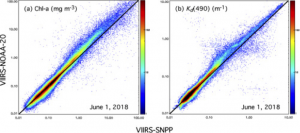
Comparison results of density plot for VIIRS-derived ocean color products over global oceans and inland waters (all pixels) on June 1, 2018 between VIIRS-N20 (with algorithm modifications) and VIIRS-SNPP for data product of (a) Chl-a (OCI algorithm) and (b) Kd(490).
In a new publication, Wang et al. (2020) developed a methodology for deriving consistent ocean biological and biogeochemical products from multiple satellite ocean color sensors that have slightly different sensor spectral characteristics. Specifically, the required coefficients for algorithm modifications are obtained using the hyperspectral in situ optical measurements from the Marine Optical Buoy (MOBY) in the water off Hawaii. It is demonstrated that using the proposed approach for modifying ocean biological and biogeochemical algorithms, satellite-derived ocean property data over the global open ocean are consistent from multiple satellite sensors, although their corresponding sensor-measured normalized water-leaving radiance spectra nLw(λ) are different. Therefore, the proposed approach allows satellite-derived ocean biological and biogeochemical products to be consistent and can therefore be routinely merged from various satellite ocean color sensors. The proposed approach can be applied to any satellite algorithms that use the input of sensor-measured nLw(λ) spectra.
News from EUMETSAT and NOAA
The Second International Operational Satellite Oceanography Symposium is announced for 25-27 May 2021 in Darmstadt. Save the date!
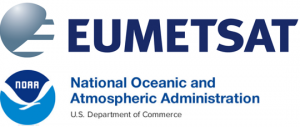 The Second International Operational Satellite Oceanography Symposium is being planned jointly by EUMETSAT and NOAA to be held 25-27 May 2021 at the Darmstadtium conference center with an optional training day on 28 May 2021 at the EUMETSAT offices, both in Darmstadt, Germany. The Programme Committee is being formed now. Please watch for details coming this summer on major symposium themes, calls for abstracts and registration information.
The Second International Operational Satellite Oceanography Symposium is being planned jointly by EUMETSAT and NOAA to be held 25-27 May 2021 at the Darmstadtium conference center with an optional training day on 28 May 2021 at the EUMETSAT offices, both in Darmstadt, Germany. The Programme Committee is being formed now. Please watch for details coming this summer on major symposium themes, calls for abstracts and registration information.
Landsat Provisional Aquatic Reflectance
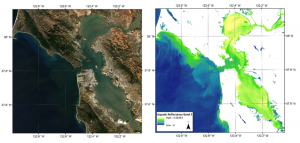
Left: Land surface reflectance natural color composite image (bands 4,3,2); Right: aquatic reflectance Band 2 (Blue band) image of San Francisco Bay, using data acquired by Landsat 8 (Path 44 Row 33) on October 7, 2018.
Landsat 8 Provisional Aquatic Reflectance is a provisional science product with the potential to make contributions to aquatic science and environmental monitoring capabilities for aquatic ecosystems, especially in coastal environments and inland water bodies. These products are available through the USGS EROS Center Science Processing Architecture (ESPA) on-demand interface. Additional customization services such as re-projection, spatial sub-setting, and pixel resizing are also available via ESPA. For further description, caveats, and constraints of the products, see https://www.usgs.gov/land-resources/nli/landsat/landsat-provisional-aquatic-reflectance.
Special Issue
![]() A special issue of the journal Remote Sensing will deal with “Remote Sensing of Air-Sea Fluxes”. The ocean–atmosphere interface marks the boundary between the two major fluid components of the climate system. Exchange of heat, moisture, momentum, gases and solid particles between the ocean and atmosphere are of fundamental importance to better understanding and improved forecasting of the weather and climate change. The journal welcomes contributions related to all aspects of remote sensing of the ocean surface and lower atmosphere for this special issue. The deadline for manuscript submissions is 31 August 2020. See https://www.mdpi.com/journal/remotesensing/special_issues/Air_Sea_Fluxes for further information.
A special issue of the journal Remote Sensing will deal with “Remote Sensing of Air-Sea Fluxes”. The ocean–atmosphere interface marks the boundary between the two major fluid components of the climate system. Exchange of heat, moisture, momentum, gases and solid particles between the ocean and atmosphere are of fundamental importance to better understanding and improved forecasting of the weather and climate change. The journal welcomes contributions related to all aspects of remote sensing of the ocean surface and lower atmosphere for this special issue. The deadline for manuscript submissions is 31 August 2020. See https://www.mdpi.com/journal/remotesensing/special_issues/Air_Sea_Fluxes for further information.
C-OPS Package Update for R

Schematic of the C-OPS deployment system from Morrow et al. (2010).
The “Cops package” was initially developed by Bernard Gentili at the Laboratoire d’Océanologie de Villefranche (LOV). It gathers several routines to process data collected using a C-OPS instrument (Compact Optical Profiling System), commercialized by Biospherical instruments. Simon Bélanger (Université de Québec à Rimouski, Canada) initially uploaded the open source code to GitHub in 2016 (available at https://github.com/belasi01/Cops). He recently released update 4.0 of the package, which includes several new features to greatly improve the overall processing of C-OPS data. A detailed README file provides information for those not familiar with the LOV Cops package, but is also recommended reading for everyone not familiar with the version 4.0 update.
Upcoming Meetings
Because of the tremendous uncertainty due to the worldwide coronavirus pandemic, many meetings have been either cancelled, rescheduled, or will be held as virtual meetings. Other meeting organizers will continue to monitor the evolving situation surrounding the pandemic before making a final decision. A list of upcoming ocean-colour related meetings is shown below – please check meeting websites before making plans to attend.
- May 26 and 28, 2020: NASA Ocean Color Research Team (OCRT) Virtual Meeting – Each day will consist of one 3-hour session from 1-4pm EDT, to provide updates on agency programs and activities, funded research, and discuss future ideas.
- June 15-19, 2020: GEO Virtual Symposium : Interactive webinars and virtual discussions.
- September, 15-19, 2020: 15th Pan Ocean Remote Sensing Conference (PORSEC), Johor Bahru, Malaysia
- September, 19-23, 2020: SPIE, Space, Satellites and Sustainability, Edinburgh, United Kingdom
- September, 22-23, 2020: NASA PACE Applications Workshop: Leveraging Science to Advance Society, Washington, DC.
- October 12-16, 2020: Oceans from Space, 5th edition, Venice, Italy
- October 24-30, 2020: Ocean Optics XXV, Norfolk, Virginia, USA. Deadline for abstract submission for oral presentations extended to 1 June 2020, poster abstracts deadline now 10 September 2020.
- December 7-10, 2020: Fall AGU meeting, San Francisco, USA (session proposals due April 23). The organizers are working to prepare for three possible scenarios: (1) A mix of virtual and in-person sessions;(2) Heavier on virtual with some in-person sessions in San Francisco, CA; and (3) 100% virtual.
- RESCHEDULED to December, 14-17, 2020: 6th Sentinel-3 Validation Team Meeting (S3VT), EUMETSAT HQ, Darmstadt, Germany
- January 11-14, 2021: 5th Xiamen Symposium on Marine Environmental Sciences, Xiamen, China
- RESCHEDULED to Jan 28 – Feb 4, 2021; 43 COSPAR Scientific Assembly, Sydney, Australia
- RESCHEDULED to May 17-21, 2021:International Liège colloquium on Ocean Dynamics: Towards an understanding and assessment of human impact on coastal marine environments (Liège, Belgium)
- May, 25-27, 2021: Second International Operational Satellite Oceanography Symposium, Darmstadt, Germany.
- RESCHEDULED to August, 23-27, 2021: Advancing Earth Observation Forum, Brisbane, Australia
New Publications
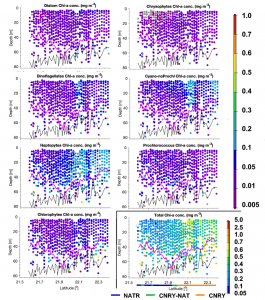
Fig. 1. Phytoplankton group Chla and Total Chla from HPLC and hyperspectral depth-resolved AOPs, along a transect within the Longhurst provinces NATR and CNRY. See Bracher et al. (2020) for details.Click to enlarge.
In a recent publication, Bracher et al. (2020) investigated the potential of using radiometric measurements obtained by a hyperspectral sensor mounted to an undulating platform towed behind a ship, to retrieve phytoplankton composition data. Different phytoplankton groups dominate ocean biomes, each driving the marine food web and biogeochemical cycling in a different manner. Their distribution throughout the ocean remains uncertain due to low sampling resolution by in situ and satellite data. Information below surface waters is especially limited because satellite sensors only provide information on the first optical depth. This study enabled robust biomass predictions of seven phytoplankton groups for several transects (50 to 150 km length) in the tropical and subtropical Atlantic Ocean, with high horizontal (~1 km) and vertical (~10 m) resolution, down to the euphotic depth and deeper. Fig. 1 shows the results from a transect in Longhurst’s (2007) North Atlantic Tropical Gyre (NATR) and Canary Current Coast (CNRY) provinces. These phytoplankton groups represent more than 90% of the total phytoplankton biomass in this ocean. The phytoplankton group data was derived by fitting empirical orthogonal functions to hyperspectral optical properties (obtained from the depth-resolved radiometric measurements), and then developing multiple linear regression models with pigment based phytoplankton group biomass as the response variable, and scores from selected empirical orthogonal function modes as predictor variables. This provides the prospect to put similar radiometers on profiling floats or gliders to enable large-scale collection of high horizontal and vertical resolved phytoplankton data.
In a related publication, Xi et al. (2020) developed an algorithm to extract up to five major phytoplankton functional types (PFTs) from multi-sensor satellite ocean colour data on a global scale. This research was supported by a collaborative project (OLCI-PFT) between the Alfred Wegener Institute and ACRI-ST. A previous empirical orthogonal functions-based approach, developed only for certain ocean regions (Bracher et al. 2015), is further extended to be used globally, and can be applied to any satellite reflectance data set which covers spectral information of at least nine different spectral bands. For algorithm development, satellite data as well as a very large globally-distributed field dataset of phytoplankton pigments (~12,000 points) is required. With data of only nine spectral bands from the merged ocean colour products, it is possible to quantify chlorophyll a concentration of different PFTs on a large scale in both space and time. Climatological characteristics of the PFTs are also evaluated based on ten years of merged products (2002−2012, Fig. 2) through inter-comparisons with other existing satellite derived products on phytoplankton composition, including phytoplankton size class, SynSenPFT, OC-PFT and PHYSAT. Preliminary experiments of the algorithm using eleven OLCI bands applied to monthly OLCI products, showed comparable PFT distributions with those from the merged ocean colour products, although the matchup data for OLCI are limited both in number and coverage. Within the framework of EU Copernicus Marine Environment Monitoring Service (CMEMS), the objective of this study is to ultimately deliver satellite global PFT products for long-term continuous observation, which will be updated with upcoming OC data, for a comprehensive understanding of the variability of phytoplankton composition structure at a global or regional scale.
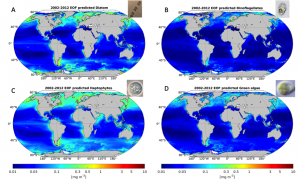
Fig. 2. Ten-year mean distribution (July 2002–April 2012) of the chl-a concentration for phytoplankton groups: (A) diatoms, (B) dinoflagellates, (C) haptophytes, and (D) green algae retrieved by EOF-based algorithm from CMEMS merged monthly remote sensing reflectance products at nine bands. Microscope images of representative species for each phytoplankton group is shown on top right of each map.
According to Cael et al., (2020), the increasing use of hyperspectral optical data in oceanography, both in situ and via remote sensing, holds the potential to significantly advance characterization of marine ecology and biogeochemistry because, in principle, hyperspectral data can provide much more detailed inferences of ecosystem properties via inversion. Effective inferences, however, require careful consideration of the close similarity of different signals of interest, and how these interplay with measurement error and uncertainty to reduce the degrees of freedom (DoF) of hyperspectral measurements. The authors discuss complementary approaches to quantify the DoF in hyperspectral measurements in the case of in situ particulate absorption measurements, though these approaches can also be used on other such data, e.g., ocean color remote sensing. Analyses suggest intermediate (∼5) DoF for their dataset of global hyperspectral particulate absorption spectra from the Tara Oceans expedition, meaning that these data can yield coarse community structure information. Empirically, chlorophyll is an effective first-order predictor of absorption spectra, meaning that error characteristics and the mathematics of inversion need to be carefully considered for hyperspectral data to provide information beyond that which chlorophyll provides. They also discuss other useful analytical tools that can be applied to this problem and place our results in the context of hyperspectral remote sensing.

Fig. 3. (a) Spectra resulting from weighted PCA of raw spectra, with associated FVA given in legend. (b) Same for normalized spectra. (c) FVA versus mode number for all spectra. See Cael et al., (2020) for details.
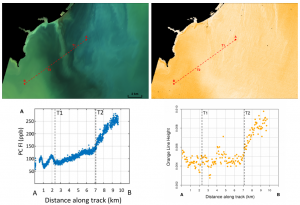
Fig. 4. Application of the orange contra-band to calculate the orange reflectance line height in west Lake Erie. See Castagna et al. (2020) for details.
In another new publication, Castagna et al. (2020) investigated spectral enhancement for the Operational Land Imager (OLI, Landsat 8) with an orange contra-band i.e., the possibility to extract an additional waveband from a system of overlapping bands (Fig. 4). When applied to the panchromatic band of OLI, overlapping with the green and red multispectral bands, it was possible to retrieve an orange contra-band (590-635 nm) over turbid inland waters. The study includes comprehensive performance evaluations covering algorithm domain, independent information content, and propagation of realistic errors and cross-validation with OLCI over a set of globally distributed lakes. Those analyses support the robustness of the current algorithm calibration over turbid inland waters and the contribution of new information to the OLI band set. This contra-band can extend the application of remote sensing for water quality studies, as it covers the phycocyanin absorption peak, and currently represents the only source of information in this spectral range at high spatial resolution, global coverage and open data policy. The method requires atmospheric correction of the panchromatic band, and is available in ACOLITE.
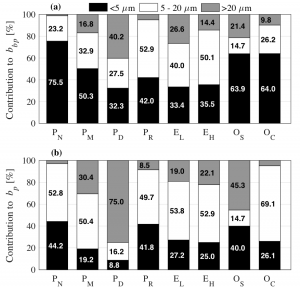
Fig. 5(a) Particulate backscattering budget in terms of contributions of particle-size fractions to total particulate backscattering coefficient. See Koestner et al. (2020) for details.
In a paper by Koestner et al. (2020), the authors examined the sources of angle-resolved light scattering in seawater by performing comprehensive measurements on natural seawater samples before and after particle-size fractionation using mesh filters with pore sizes of 5 μm and 20 μm. Measurements of the particulate volume scattering function at light wavelength of 532 nm, particle size distribution (PSD), and several metrics of particulate concentration and composition were made on contrasting seawater samples from near-shore and coastal oceanic environments including river estuary and offshore locations. Figure 5 summarizes results based on direct size-fractionated measurements following adjustments for imperfect fractionation. Despite intricate interplay between the effects of particle size and composition, small particles (< 5 μm in size) consistently produced a major or dominant contribution to the particulate backscattering coefficient, bbp, in organic (either phytoplankton or non-algal) dominated samples regardless of significant variations in PSD between these samples (PN, PM, OS, OC). The notable exception was a sample dominated by large-celled diatoms from microphytoplankton size range, which exemplifies a scenario when large particles (> 20 μm) can produce a considerable contribution to bbp (PD). Inorganic-dominated samples exhibited consistently lower contributions of small particles to bbp (EL and EH). The particle size-based budget for the particulate scattering coefficient, bp, indicates a significant decrease in the role of small particles accompanied by an increase in the role of larger particles compared to the bbp budget (Fig. 5).
Lastly, Zibordi and Talone (2020) investigated the equivalence of two radiometric methods relying on a single nadir-view optical sensor to determine the water-leaving radiance Lw, namely the Single Depth Approach (SDA) and the Sky-Blocked Approach (SBA). They used identical hyperspectral radiometers operated on the same deployment platform (Fig. 6). Values of Lw from SDA and SBA measurements performed in the Black Sea across a variety of waters during ideal illumination conditions and with low-to-slight sea state exhibit mean absolute differences within 0.5% in the blue-green spectral region and 2% in the red. This result, benefitting of a comprehensive parameterization of optical processes in combination with the characterization of sensors non-linearity, in-water response and reproducibility of absolute radiometric calibrations, indicates ample equivalence of the two near-surface methods in terms of performance and data reduction needs.
Employment Opportunities
Several new positions have been added to the Employment Opportunities section on the IOCCG website, including post-doctoral positions at the University of Victoria (Canada), MIO/MARBEC (France) and UC Merced (California, USA), as well as a PACE Mission Communications position at NASA GSFC (Greenbelt, USA). For more information on these, and other positions see http://ioccg.org/resources/employment-opportunities/.


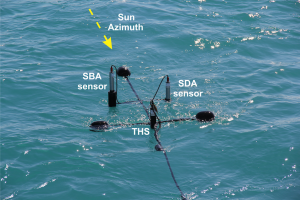

 The sixth International Ocean Colour Science (IOCS) meeting will take place in Darmstadt, Germany from 1 – 4 December 2025, hosted by EUMETSAT and ESA with support from other agencies.
The sixth International Ocean Colour Science (IOCS) meeting will take place in Darmstadt, Germany from 1 – 4 December 2025, hosted by EUMETSAT and ESA with support from other agencies.